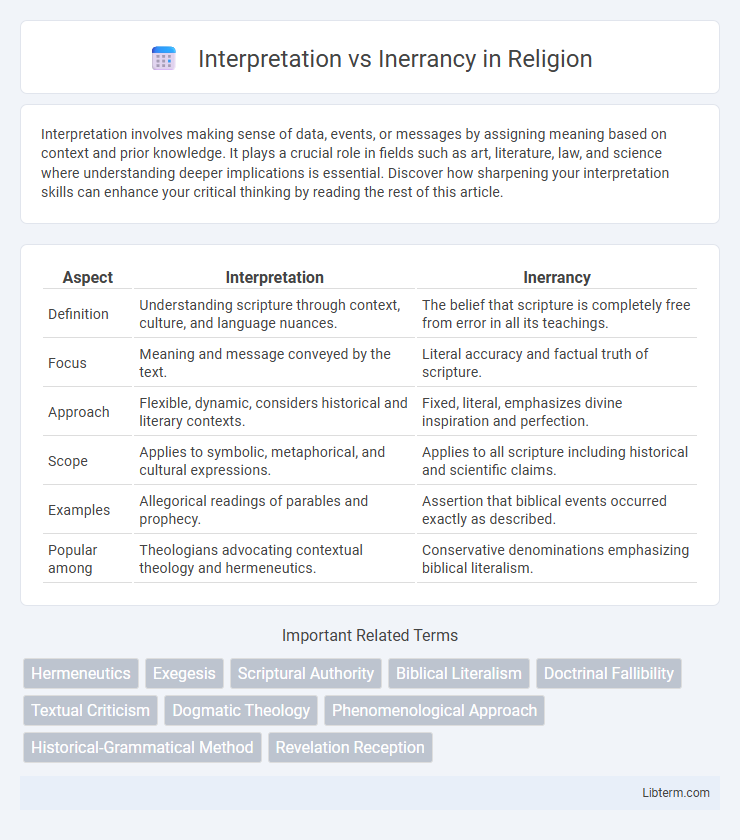Interpretation involves making sense of data, events, or messages by assigning meaning based on context and prior knowledge. It plays a crucial role in fields such as art, literature, law, and science where understanding deeper implications is essential. Discover how sharpening your interpretation skills can enhance your critical thinking by reading the rest of this article.
Table of Comparison
| Aspect | Interpretation | Inerrancy |
|---|---|---|
| Definition | Understanding scripture through context, culture, and language nuances. | The belief that scripture is completely free from error in all its teachings. |
| Focus | Meaning and message conveyed by the text. | Literal accuracy and factual truth of scripture. |
| Approach | Flexible, dynamic, considers historical and literary contexts. | Fixed, literal, emphasizes divine inspiration and perfection. |
| Scope | Applies to symbolic, metaphorical, and cultural expressions. | Applies to all scripture including historical and scientific claims. |
| Examples | Allegorical readings of parables and prophecy. | Assertion that biblical events occurred exactly as described. |
| Popular among | Theologians advocating contextual theology and hermeneutics. | Conservative denominations emphasizing biblical literalism. |
Understanding Biblical Interpretation
Understanding biblical interpretation involves recognizing the distinction between interpretation and inerrancy. Biblical interpretation seeks to uncover the intended meaning of Scripture through historical, cultural, and linguistic context analysis, while inerrancy asserts the Bible's complete truthfulness and freedom from error in its original manuscripts. Effective interpretation respects inerrancy by striving to accurately convey the text's divine message without neglecting human literary forms and historical circumstances.
Defining Inerrancy in Scripture
Inerrancy in Scripture asserts that the Bible, in its original manuscripts, is without error or fault in all its teachings, including theology, history, and moral guidance. This doctrine upholds that the Bible's divine inspiration guarantees complete truthfulness and reliability. Interpretation involves understanding the context, language, and intent of biblical texts while maintaining the belief that the Scriptures remain wholly truthful and authoritative.
Historical Perspectives on Interpretation
Historical perspectives on interpretation reveal diverse views on biblical inerrancy, with early church fathers like Augustine emphasizing the importance of allegorical readings to reconcile apparent scriptural contradictions. The Protestant Reformation marked a shift towards sola scriptura, promoting literal and historical-grammatical interpretations while grappling with perceived errors in transmission. Enlightenment thinkers introduced critical methods that challenged traditional inerrancy, advocating for contextual and textual analysis to understand scripture's historical development.
The Origins of the Inerrancy Doctrine
The origins of the inerrancy doctrine trace back to early 19th-century American Protestantism, particularly through the Princeton Theological Seminary, where scholars like B.B. Warfield emphasized the Bible's complete truth and freedom from error in all its assertions. This doctrine emerged as a response to rising biblical criticism and liberal theology that questioned the Bible's historicity and accuracy. The inerrancy stance asserts that Scripture, in its original manuscripts, is without error in all its teachings, encompassing theological, historical, and scientific content.
Key Differences: Interpretation vs Inerrancy
Interpretation involves the analysis and explanation of texts, considering context, language, and cultural factors, while inerrancy asserts that a text, often religious scripture, is without error in its original form. Interpretation acknowledges human perspectives and variations in understanding, whereas inerrancy maintains the absolute truth and flawless accuracy of the document. Key differences lie in the acceptance of potential subjective influences in interpretation versus the strict divine perfection claimed by inerrancy.
The Role of Context in Biblical Interpretation
Context plays a critical role in biblical interpretation, influencing how passages are understood without compromising the doctrine of inerrancy. Understanding historical, cultural, linguistic, and literary contexts helps clarify the intended meaning of Scripture, ensuring interpretations align with the original message. Proper contextual analysis maintains the integrity of biblical truth while respecting the inerrant nature of the text.
Common Misconceptions about Inerrancy
Inerrancy is often misunderstood as requiring a literal, word-for-word interpretation of scripture, but it actually pertains to the Bible's truthfulness and reliability in its original manuscripts rather than a strict literalism. Many assume inerrancy means the absence of any errors or contradictions in every translation and interpretation, while scholars emphasize that the doctrine applies specifically to the original texts inspired by God. Misconceptions also arise when critics conflate inerrancy with infallibility, although inerrancy asserts the absence of error in all assertions of truth, particularly about faith and practice.
Hermeneutical Approaches and Their Impact
Hermeneutical approaches to biblical texts profoundly influence the debate between interpretation and inerrancy, shaping how Scripture's truthfulness is understood and applied. Literal interpretation emphasizes inerrancy by asserting the Bible's absolute accuracy in all details, while historical-critical methods prioritize contextual analysis, allowing for metaphorical or cultural nuances that may appear to challenge strict inerrancy. These differing frameworks affect theological doctrines, doctrinal authority, and the way believers engage with Scripture, underscoring the importance of hermeneutics in mediating between divine inspiration and human understanding.
Contemporary Debates: Relevance Today
Contemporary debates on interpretation versus inerrancy center on how scripture is understood in modern contexts, emphasizing hermeneutical approaches that balance historical accuracy with theological relevance. Scholars argue that rigid inerrancy may limit interpretative flexibility needed to address evolving ethical and cultural issues, while proponents maintain that flawless scriptural authority ensures doctrinal consistency. The ongoing discourse highlights the tension between preserving foundational beliefs and adapting to contemporary existential questions within religious communities.
Navigating Faith: Balancing Interpretation and Inerrancy
Navigating faith involves balancing the interpretation of sacred texts with the doctrine of inerrancy, recognizing that interpretation shapes understanding while inerrancy asserts the texts are without error. Scholars and believers engage in hermeneutics to discern meaning within historical and cultural contexts, ensuring that faith remains both intellectually honest and spiritually meaningful. This dynamic interaction fosters a robust faith that respects scriptural authority while allowing for thoughtful exegesis.
Interpretation Infographic

 libterm.com
libterm.com